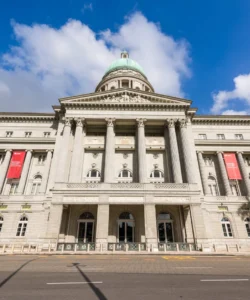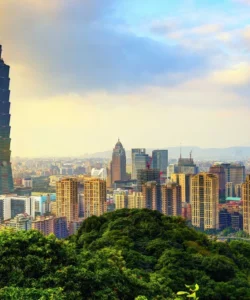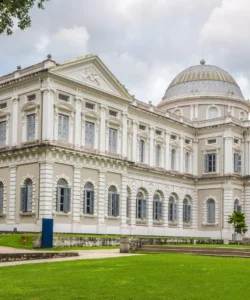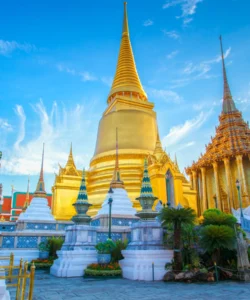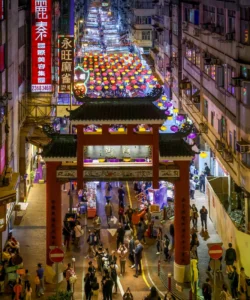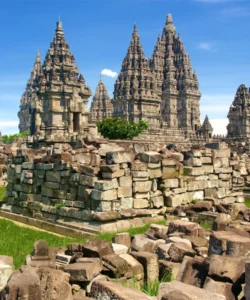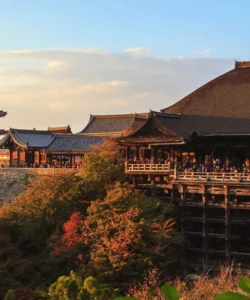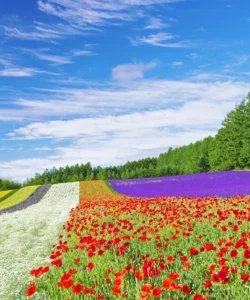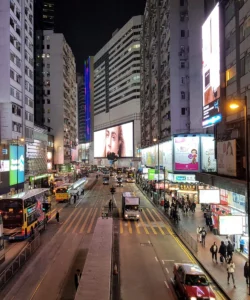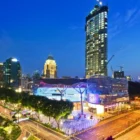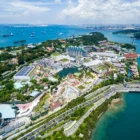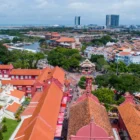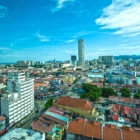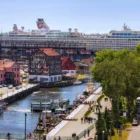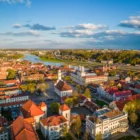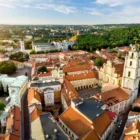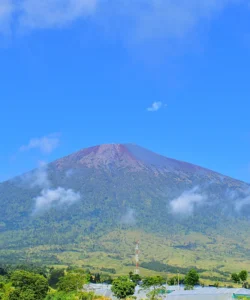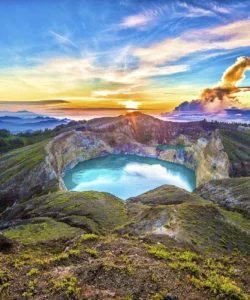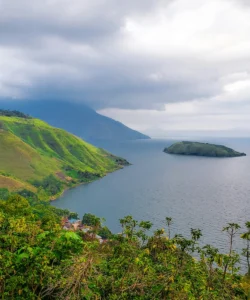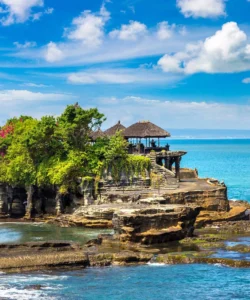The Singapore Botanic Gardens is a sprawling, lush green lung located right in the heart of Singapore, embodying the nation’s “City in a Garden” vision. Established in 1859, it is not only a tranquil oasis for recreation but also a world-renowned scientific institution and a living testament to tropical botanical research and conservation.
Name: Singapore Botanic Gardens
Address: 1 Cluny Road, Singapore 259569 (This address refers to the Botany Centre at the Tanglin Entrance, one of several gates). The Gardens are extensive, with multiple entrances: Tanglin Gate (main entrance), Nassim Gate, Bukit Timah Gate, and Tyersall Gate (leading to the Learning Forest and National Orchid Garden).
How to Get There:
The Singapore Botanic Gardens are easily accessible from various parts of the city, with several MRT stations conveniently located near its different gates.
- By MRT (Mass Rapid Transit):
- Botanic Gardens MRT Station (Circle Line CC19 / Downtown Line DT9): This station is directly connected to the Bukit Timah Gate, offering easy access to the Eco-Lake, Jacob Ballas Children’s Garden, and the Learning Forest.
- Napier MRT Station (Thomson-East Coast Line TE12): This station provides direct access to the Tanglin Gate, which is closest to the Swan Lake, Bandstand, and the main visitor center.
- Orchard MRT Station (North-South Line NS22): While not directly at a gate, it’s a short bus ride from Orchard Road to the Tanglin Gate.
- By Bus: Numerous public bus routes stop near various gates of the Gardens (e.g., along Napier Road for Tanglin Gate, or Bukit Timah Road for Bukit Timah Gate).
- By Taxi/Ride-Sharing (Grab, Gojek, Tada): A convenient option for direct drop-off at any of the gates.
- By Car: Parking is available at various entrances (Tanglin, Nassim, Tyersall, Bukit Timah).
Landscape and Architecture:
The Singapore Botanic Gardens boasts a meticulously designed landscape that fuses formal gardens with naturalistic elements, reflecting its dual purpose as a pleasure garden and a scientific institution.
- British Colonial Landscape Style: The Gardens were originally laid out in the 1860s by Lawrence Niven in the English Landscape style, emphasizing free-flowing layouts, naturalistic designs, and picturesque vistas, which is unique for a historic tropical garden.
- Diverse Thematic Zones: The vast 82-hectare site is divided into several distinct zones, each with its own character and purpose:
- National Orchid Garden (Paid Entry): The undisputed star attraction, housing the world’s largest display of orchids with over 1,000 species and 2,000 hybrids. It features vibrant displays, a cool house, and the famous VIP Orchid Garden where hybrids are named after visiting dignitaries.
- Tropical Rainforest: A preserved 6-hectare (15-acre) patch of primary rainforest, predating the Gardens by centuries, allowing visitors to experience the dense, multi-layered jungle that once covered Singapore. It includes towering heritage trees.
- Swan Lake: A picturesque ornamental lake with a Victorian gazebo and iconic swans, a tranquil spot for relaxation and photography.
- Symphony Lake & Shaw Foundation Symphony Stage: A large lake with a floating stage that hosts free outdoor concerts, creating a unique cultural experience amidst nature.
- Ginger Garden: A sensory garden dedicated to the diverse family of ginger plants, complete with a waterfall.
- Evolution Garden: An educational journey through the history of plant life on Earth, showcasing plants from different geological eras.
- Jacob Ballas Children’s Garden: Asia’s first garden dedicated to children, providing interactive play areas, treehouses, and water features, aimed at connecting kids with nature.
- Healing Garden, Fragrant Garden, Bonsai Garden, Sun Garden: Various other specialized thematic gardens.
- Heritage Trees and Structures: The Gardens are home to numerous Heritage Trees, some over 100 years old, including the famous “five dollar Tembusu tree” (featured on Singapore’s $5 note). Historic buildings like Burkill Hall (a beautifully preserved Anglo-Malay plantation house, built in 1868, used for VIP orchid naming ceremonies), Holttum Hall (housing a heritage museum), and the Bandstand (an octagonal gazebo from 1930 that often serves as an iconic photo spot) are scattered throughout, adding architectural charm and historical depth.
- Modern Research Facilities: The Botany Centre and Green Pavilion (built in 2006) feature modern research facilities and sustainable design elements like Singapore’s first pitched green roof, showcasing the Gardens’ ongoing scientific mission.
What Makes It Famous:
- UNESCO World Heritage Site: Inscribed in 2015, the Singapore Botanic Gardens is the first and only tropical botanic garden on the UNESCO World Heritage List, and the third botanic garden globally to receive this recognition. This cements its international significance in terms of heritage, science, and landscape design.
- National Orchid Garden: World-renowned for its stunning and extensive collection of orchids, including its highly successful orchid breeding program (started in 1928) and the VIP Orchid Naming Programme, where new hybrids are named after visiting dignitaries and celebrities.
- Pioneer in Rubber Cultivation: The Gardens played a pivotal role in the development and expansion of the rubber industry in Southeast Asia in the early 20th century, particularly through the work of Henry Nicholas Ridley (affectionately known as “Mad Ridley”) who perfected the rubber tapping technique.
- Ancient Rainforest within a City: The preservation of a significant patch of primary rainforest within the city limits is a remarkable feat and a major draw, allowing visitors a unique glimpse into Singapore’s ecological past.
- “City in a Garden” Embodiment: It’s a foundational element of Singapore’s vision to be a “City in a Garden,” showcasing how rich biodiversity and green spaces can be integrated into an urban environment.
- Free and Accessible Green Space: The majority of the Gardens (excluding the National Orchid Garden) are free to enter and open from 5 AM to midnight daily, making it an incredibly accessible and cherished recreational space for both locals and tourists.
Differences from Some Other Wonders:
- Dual Role as Pleasure Garden and Scientific Institution: Unlike pure pleasure gardens or theme parks, the Singapore Botanic Gardens has always maintained a strong scientific and research mandate alongside its recreational function. Its contributions to tropical botany and horticulture (especially rubber and orchids) are a key differentiator.
- UNESCO Status for Botanical and Horticultural Heritage: While other Singaporean sites like Gardens by the Bay are famous for modern biophilic design and reclaimed land transformation, the Botanic Gardens’ UNESCO status specifically recognizes its historical evolution as a British tropical colonial botanic garden and its enduring scientific contributions.
- Extensive Living Plant Collection: While museums like the Islamic Arts Museum Malaysia house art, the Botanic Gardens is a living museum of plants, with active plant breeding, conservation, and research programs that constantly evolve its “collection.”
- Historical Depth (1859 Foundation): Its long history dating back to 1859, with well-preserved landscape designs and structures from the 19th and early 20th centuries, provides a deep historical context that contrasts with newer, purpose-built attractions (like Legoland, Sunway Lagoon, or even Gardens by the Bay).
- Naturalistic Landscape Style: Compared to the more geometrically structured or overtly “themed” landscapes of places like Gardens by the Bay (with its Supertrees), the Botanic Gardens’ design largely adheres to the naturalistic English Landscape movement, creating a serene and seemingly untouched feel despite its meticulous curation.
- Integration of a Primary Rainforest: The rare presence of an actual, ancient primary rainforest within its bounds, rather than a man-made rainforest environment (like Cloud Forest in Gardens by the Bay or Fragile Forest in Singapore Zoo), offers a truly authentic ecological experience.
Singapore Botanic Gardens Photos:































